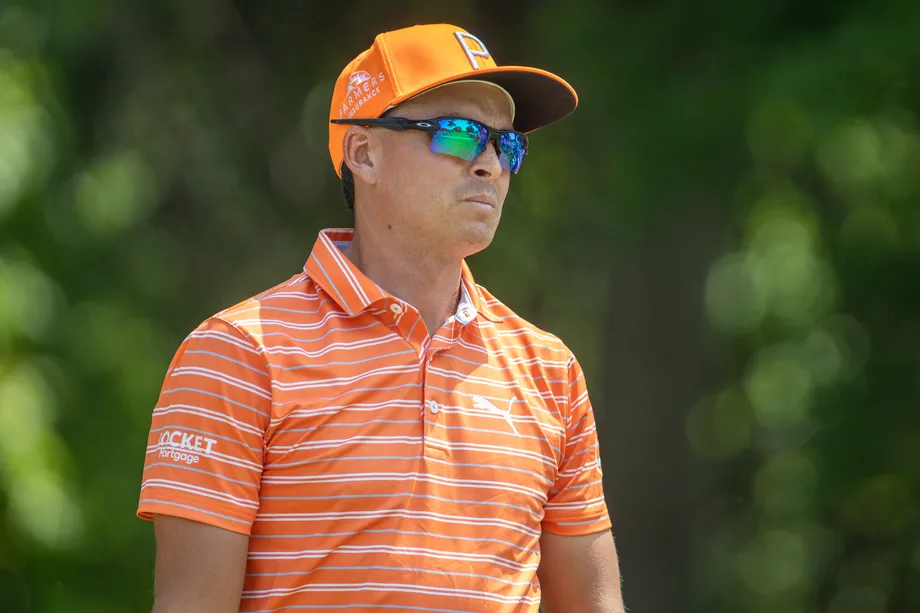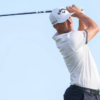On Thursday, Los Angeles Country Club was covered in a marine layer that matched his grey pullover, but he was able to see through the gloomy skies thanks to his prescription sunglasses.
That alone demonstrated that the Rickie Fowler we are dealing with is not the same man he formerly was; he is now a father. Years ago, his clothes sponsor would have given him a statement-making wardrobe full of vivid colors and eye-catching patterns on the big stage of a major championship.
Not this time around. Rather than standing out, Fowler’s white and grey attire blended in. He might have been showing signs of aging. He most certainly was during his Tuesday warm-up. Fowler, 34, played with a college student who had been dressing up as him for years. Around age 9, Michael Brennan adopted the all-orange ensemble, white belt, and flat-brim hat that had become Fowler’s signature.
Additionally, it was the lowest score in U.S. Open history, beating Johnny Miller’s mark from 50 years prior. Miller was present this week to accept the USGA’s Bob Jones Award and commemorate the 50th anniversary of the most illustrious round in this competition. In addition, Fowler’s score of 62 tied Branden Grace’s performance at the 2017 Open competition for the lowest score in a major competition.

“I was aware that there were birdies to be had, but you have to drive it well and place the ball first. We did that and then simply navigated the area quite nicely.” Fowler said.
Minutes later, Xander Schauffele equaled his 62. Although the opening round of the U.S. Open had the lowest score in history, the leaders are still two strokes ahead of their closest rivals and five shots ahead of the players who make up the top ten. By double digits, Fowler defeated his playing companions, a pair of major winners who each claimed victory on the PGA TOUR in 2023. In Fowler’s group, Justin Rose shot 76, while Day shot 73.
“It was fun watching it. That, without a doubt, was the best part of my day.” Rose said.
Even though Fowler is having his finest season in years, he did not expect this round, especially after several lackluster practice rounds and a similarly drab warm-up on Thursday morning. Los Angeles Country Club’s 10th hole was Fowler’s first birdie, but he bogeyed the next hole right away. He eagled the third hole before adding three more Eagles and a bogey to score 32 on the more difficult back nine.
After turning around, he eagled his first three holes to get to 6 under par and had only two pars through his opening 12 holes. He reached 7 under par after making another birdie on the short sixth hole before taking advantage of a favorable break on the eighth par-5 hole to get to 8 under.
On hole No. 8, where players are required to remove some distance off their tee shots due to a
barranca that runs along the right side of the hole before crossing the fairway, Fowler was taken aback when his tee shot soared towards the barranca. But when he noticed where the ball had settled, he felt relieved.
When a player’s ball lands on the short grass at Los Angeles Country Club, a little amount of luck is required. This unassuming design paints a vision of the land’s previous appearance before it was encircled by asphalt. Sand, stones, and indigenous vegetation cover the sandy barrancas. In addition to avoiding the dense grass, Fowler’s ball was also in line with a small gap between a group of trees and the bridge that players use to cross the wash.
In order to set up his 104-yard wedge shot that he hammered to 13 feet for his day’s tenth and final birdie, he was able to hit a pitching wedge back to the fairway. In his second stroke, Fowler claimed he made a quick judgment, letting his instincts take precedence over his more analytical side.
“Really, I just tried to respond to it and strike it very swiftly without giving it any thought. I was simply attempting to catch cleanly and fade up a pitching wedge into the wind. In those circumstances, it’s sometimes best to simply intervene, respond, and strike without giving it any thought.” he said.
At that point, Fowler performs at his peak. Being right-brained, he performs at his peak on courses that call for inventiveness. He enjoys altering his trajectory and shaping his shots. That is one of the reasons why Fowler has improved since having Butch Harmon as a teacher again last year. In the age of big data, Harmon is proudly and almost aggressively old-school. He is more focused on boosting a player’s confidence than on the specifics of his launch.
“Keep it easy and just play some golf,” Fowler said.
The outcomes came as a result. After recently being outside the top 150, he has climbed back to the top 50 in the world rankings. He sat around the entire first round as a U.S. Open alternate the previous year before finishing the day as the odd man out. Since 2019, when he won his most recent triumph, he has had six top-10 finishes this season.
“As long as you keep working hard and believe in yourself, as Rickie has done, you will experience ups and downs in your career. This year, he has climbed all the way back and has been playing some really good golf,” said World Number 1 Scottie Scheffler.
It would seem that Fowler’s style would fit well at Los Angeles Country Club. It is evocative of the location where Fowler finished second at the 2014 U.S. Open, his best result there. At Pinehurst No. 2, another classic course Gil Hanse renovated, that competition was held. The rustic aesthetic of both courses is evident in the darker brown hues more frequently associated with an Open Championship.
In a season in which he placed in the top five at each major championship, Fowler finished in second place at Pinehurst. He was once ranked as high as fourth in the world and won THE PLAYERS the following season. Fowler claimed on Thursday that he now feels more connected to that form.
“It has undoubtedly been hard and difficult. You would never want to stay there for as long as you did. But having gone through it and being back where we are now makes it so worth it.” he said.



